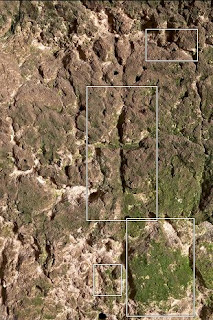The lush valley facing the Chapel of Our Lady of Itria, known as the "Jewish Caves" (Maltese: "Gherien L-Lhud", so called because caves in the area were historically associated with burial practices of early Jewish communities in Malta), bear a strong physical resemblance to the Golgotha of scripture (see Further note: "a") [1]. The tombs also display features identified in scripture with the sepulchre of Christ. [2]
 |
Figure 1: The south facing escarpment of Gherien Lhudi
is a honeycomb of caves.
Photo: Author, August 28 2013 |
The toponymy of the caves suggests a historical connection to the Jewish catacombs that formed part of the hypogea of Saints Paul and Agatha in the nearby town of Rabat rediscovered at the end of the 19th century and which have been dated back to the late Roman period between A.D. 300 and A.D. 500 [3], [4].
 |
| Figure 2: The spatial orientation of the upper and lower cave systems differ due to topography. Photo: Author, August 28 2013 |
 |
| Figure 3: A recessed tomb entrance within a cave situated at the lower level , about 3 metres above the valley floor. Photo: Author, August 28 2013 |
 |
Figure 4: The Christian cross and the
letters "M" and "A" are visible on what appears to be a tomb stone.
Photo: William Attard McCarthy, 2008
|
 |
Figure 5: The view of the Chapel of Our Lady of the Way
from the Jewish caves.
Photo: Author, August 28 2013 |
a. Golgotha (Heb. גֻּלְגֹּלֶת pronounced gol-go-thä') is a proper locative noun derived from Gulgoleth (Heb.גֻּלְגֹּלֶת pronounced gul·gō'·leth) a feminine noun which means (i) head, skull or (ii) individual head, in the context of a census. A more primitive root galal (Heb. גָּלַל pronunced gä·lal') means to roll away. The stone that was rolled away from the mouth of the well to water sheep (Gen 29:3; Gen 29:8). Jacob upon seeing Rachel, rolls away the stone from the mouth of the well to water her father's sheep (Gen 29:10).
b. The Eastern Orthodox Tradition venerate the Kiev Monastery of the Caves on the 28th August. Also known as Lavra, it has been a preeminent center of the eastern spirituality since 1051 and is today a UNESCO World Heritage Site. The Lavra also houses relics (the head) of Pope Clement I (Saint Clement of Rome), the first of the successors of St. Peter of whom anything definite is known, and the first of the Apostolic Fathers. His feast is celebrated on the 23 November in the Roman Catholic Tradition. His remaining relics were taken to San Clemente in Rome by Sts. Cyril and Methodius. [7],[8] The Kiev Monastery of the Caves was founded by Saint Anthony of the Caves who had originally joined a monastery at Mount Athos [9].
c. Two kilometres north of the caves we find the Parish of Mġarr with Basilica of the Assumption of the Blessed Virgin which is closely modelled on the Mosta dome, albeit on a smaller scale. The basilica is distinguished by its unusual oval shaped dome (Figure 6) and imposing classic portico (Figure 7) [10].
 |
| Figure 6: Unusual oval shaped dome at the Basilica of the Blessed Virgin in Mġarr. Photo: Daniel Cilia, 2011 |
 |
Figure 7: Foundation stone laid of the Basilica was laid down
in 1912. Works were completed in 1946. [10] Photo: Daniel Cilia, 2011 |
[1] Matt 27:33, Mark 15:22 John 19:17
[2] John 20:1
[3] Jewish bones in Rabat are ours by Kurt Sansone Sunday, February 22, 2009. Accessed on the 29th August 2013.
[4] Ancient Jewish Art and Archaeology in the Diaspora, By Rāḥēl Ḥa̱klîlî, p. 273-274. Accessed on Google books on 29th August.
[5] Photo by William Attard McCarthy (2008). Accessed on the 29th August 2013.
[6] Buhagiar M (1998). Four new late Roman and Early Byzantine sites on the island of Malta p. 34. Accessed on the 28th August 2013.
[7] Magocsi P.R. A History of Ukraine. University of Toronto Press: Toronto, 1996. p 98. Accessed via Wikipedia article on the Kiev Monastery Caves on the 28th August.
[10] www.oneweekholiday.com: Mgarr Parish Church. Accessed on the 29th August 2013.
No comments:
Post a Comment